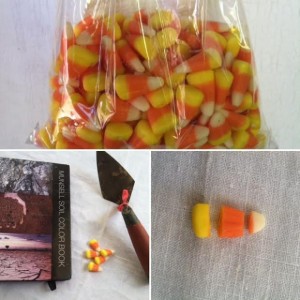By: Genevieve Everett
Side note: THIS SATURDAY, OCTOBER 15th from 12-3pm at McElhaney Hall on the Ground Floor is our INTERNATIONAL ARCHAEOLOGY DAY event! Come one, come all!
What’s Halloween without candy? I remember having the occasional box of raisins or
bag of pretzels thrown in my pillow case , and for most children, this was unacceptable! When I think of Halloween candy, I think of CANDY CORN! For those that have never had the tiny morsel’s, they are pure sugar shaped into what you’re supposed to assume is little kernels of corn? Who knows? Whatever it is, I love it! Time to Munsell!
, and for most children, this was unacceptable! When I think of Halloween candy, I think of CANDY CORN! For those that have never had the tiny morsel’s, they are pure sugar shaped into what you’re supposed to assume is little kernels of corn? Who knows? Whatever it is, I love it! Time to Munsell!
So, as you can see in the photograph, I ‘dissected’ the candy corn into three parts: white, orange and yellow. I pulled out the handy, dandy Munsell and put the white piece to the test, and guess what? There is a ‘WHITE’ section at the very back of the Munsell Color Book. I wanted to know what makes soil white, and this is what I found out, “Clear or white (soils), usually due to the presence of calcium and magnesium carbonates, gypsum or other more soluble salts”. Cool! So, the white piece came out (to me) as 2.5Y9.5/1….WHITE! Next, I took the yellow piece of the candy corn and tested it against the several yellowish colors. Yellows in the Munsell vary from straight up yellow to varying hues of reddish yellows and brownish yellows. The closest I could come to this bright yellow candy was 2.5Y8/8…YELLOW! Last, but no least, the orange piece. First I want to point out tha t the word orange does not show up in the Munsell Color Book ONCE. According to the Munsell color blog, “orange isn’t part of Munsell’s primary hue color. The color is represented in Munsell’s “intermediate hues”—the colors between two primary hues. So the color orange is referred to as “yellow-red” (YR) because it is located between the primary hues, red and yellow”. This does not mean that orange doesn’t exist naturally in the natural world. SO, this led me to look at the reddish yellows. I went back and forth between 5YR and 7.5YR…and I decided the orange that is candy corn orange does not fit any of the Munsell colors. It’s its own unique combination of yellow 5 and red 3 dye!
t the word orange does not show up in the Munsell Color Book ONCE. According to the Munsell color blog, “orange isn’t part of Munsell’s primary hue color. The color is represented in Munsell’s “intermediate hues”—the colors between two primary hues. So the color orange is referred to as “yellow-red” (YR) because it is located between the primary hues, red and yellow”. This does not mean that orange doesn’t exist naturally in the natural world. SO, this led me to look at the reddish yellows. I went back and forth between 5YR and 7.5YR…and I decided the orange that is candy corn orange does not fit any of the Munsell colors. It’s its own unique combination of yellow 5 and red 3 dye!
To learn more about ‘hue, value, and chroma’, click the first link “Soil Color Never Lies”, below!
Cited material:
http://blogs.egu.eu/divisions/sss/2014/03/30/soil-color-never-lies/